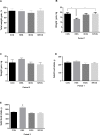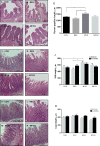Milk restriction or oligosaccharide supplementation in calves improves compensatory gain and digestive tract development without changing hormone levels
- PMID: 30921423
- PMCID: PMC6438680
- DOI: 10.1371/journal.pone.0214626
Milk restriction or oligosaccharide supplementation in calves improves compensatory gain and digestive tract development without changing hormone levels
Abstract
We estimated the effect of oligosaccharide supplementation and feed restriction on calves. The study was divided into two experimental periods of 28 days each with 20 crossbred calves that had initial body weight of 37 Kg and housed in individual pens. The animals were split in four experimental groups: animals fed 6 L milk/day (CON) in the two periods, animals fed milk restricted (3 L milk/day) in the first period and followed by CON feeding in the second period (RES), animals receiving supplementation of 5 g/day of mannanoligosaccharide (MOS) and animals receiving supplementation of 5 g/day mannan and frutoligosaccharide (MFOS). At the end of the study, all the animals were slaughtered. The average weight gain was lower in the restricted group when compared with CON and MFOS groups in the first period (P < 0.05) and there were no difference among the groups in the second period. Animals supplemented with MOS showed a significant increases in jejunal villus height and rumen papillae, which were not observed for MFOS group (P < 0.05) compared with RES and CON groups. There were no difference in ghrelin and leptin levels among treatments during periods 1 and 2 (P > 0.05). Also, the expression of ghrelin receptors in the paraventricular region of the hypothalamus did not differ among groups. We conclude that milk restriction during the first weeks of life in calves resulted in compensatory gain and did not modify the hormonal profile and expression of the ghrelin receptor in the hypothalamus. Moreover, a prebiotic supplementation changed the development of intestinal and ruminal epithelium.
Conflict of interest statement
The experiment was funded in part by YES Company – supplies, animals, feed and reagents; and by FAPEG - doctoral student scholarship. This does not alter our adherence to PLOS ONE policies on sharing data and materials.
Figures





Similar articles
-
Performance and serum parameters of calves (Bos taurus) subject to milk restriction associated with supplementation with 2-hydroxy-4-(methylthio)butanoic acid.J Anim Sci. 2021 Jun 1;99(6):skab104. doi: 10.1093/jas/skab104. J Anim Sci. 2021. PMID: 33914885 Free PMC article.
-
Effects of feeding unlimited amounts of milk replacer for the first 5 weeks of age on rumen and small intestinal growth and development in dairy calves.J Dairy Sci. 2018 Jan;101(1):783-793. doi: 10.3168/jds.2017-13247. Epub 2017 Oct 18. J Dairy Sci. 2018. PMID: 29055538
-
Effects of Saccharomyces cerevisiae fermentation products on dairy calves: Ruminal fermentation, gastrointestinal morphology, and microbial community.J Dairy Sci. 2016 Jul;99(7):5401-5412. doi: 10.3168/jds.2015-10563. Epub 2016 May 4. J Dairy Sci. 2016. PMID: 27157569
-
Potential benefits of early-life supplementation of liquid feed with fennel (Foeniculum vulgare) seeds or oregano (Origanum vulgare) leaves on growth, health, and blood metabolites in Holstein dairy calves.J Dairy Sci. 2022 Aug;105(8):6639-6653. doi: 10.3168/jds.2022-21776. Epub 2022 Jul 2. J Dairy Sci. 2022. PMID: 35787321
-
Invited review: Use of butyrate to promote gastrointestinal tract development in calves.J Dairy Sci. 2018 Jun;101(6):4785-4800. doi: 10.3168/jds.2017-14086. Epub 2018 Mar 7. J Dairy Sci. 2018. PMID: 29525310 Review.
Cited by
-
Effect of Milk-Feeding Frequency and Calcium Gluconate Supplementation on Growth, Health, and Reproductive and Metabolic Features of Holstein Heifers at a Rearing Farm.Animals (Basel). 2024 Apr 29;14(9):1336. doi: 10.3390/ani14091336. Animals (Basel). 2024. PMID: 38731339 Free PMC article.
-
Nutrient digestibility, ruminal fermentation, and blood metabolites of growing cattle-fed fermented cassava pulp with added flavoring agents.J Adv Vet Anim Res. 2023 Sep 24;10(3):437-448. doi: 10.5455/javar.2023.j697. eCollection 2023 Sep. J Adv Vet Anim Res. 2023. PMID: 37969794 Free PMC article.
-
Supplementation with galacto-oligosaccharides in early life persistently facilitates the microbial colonization of the rumen and promotes growth of preweaning Holstein dairy calves.Anim Nutr. 2022 May 11;10:223-233. doi: 10.1016/j.aninu.2022.04.009. eCollection 2022 Sep. Anim Nutr. 2022. PMID: 35785255 Free PMC article.
-
Performance and serum parameters of calves (Bos taurus) subject to milk restriction associated with supplementation with 2-hydroxy-4-(methylthio)butanoic acid.J Anim Sci. 2021 Jun 1;99(6):skab104. doi: 10.1093/jas/skab104. J Anim Sci. 2021. PMID: 33914885 Free PMC article.
-
Postnatal Growth and Development of the Rumen: Integrating Physiological and Molecular Insights.Biology (Basel). 2024 Apr 18;13(4):269. doi: 10.3390/biology13040269. Biology (Basel). 2024. PMID: 38666881 Free PMC article. Review.
References
-
- Guilloteau P, Zabielski R, Blum JW. Gastrointestinal tract and digestion in the young ruminant: ontogenesis, adaptations, consequences and manipulations. J Physiol Pharmacol. 2009;60: 37–46. - PubMed
-
- Lalles JP, Bosi P, Smidt H, Stokes R. Nutritional management of gut health in pigs around weaning. Proc Nutrit Soc. 2007;66: 260–268. - PubMed
Publication types
MeSH terms
Substances
LinkOut - more resources
Full Text Sources
Medical

